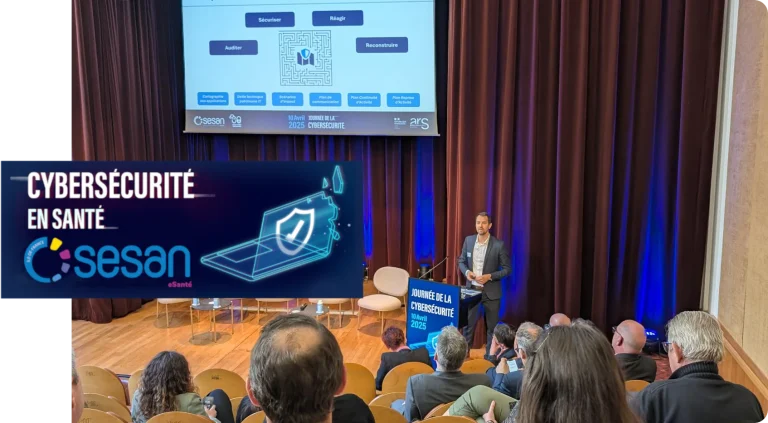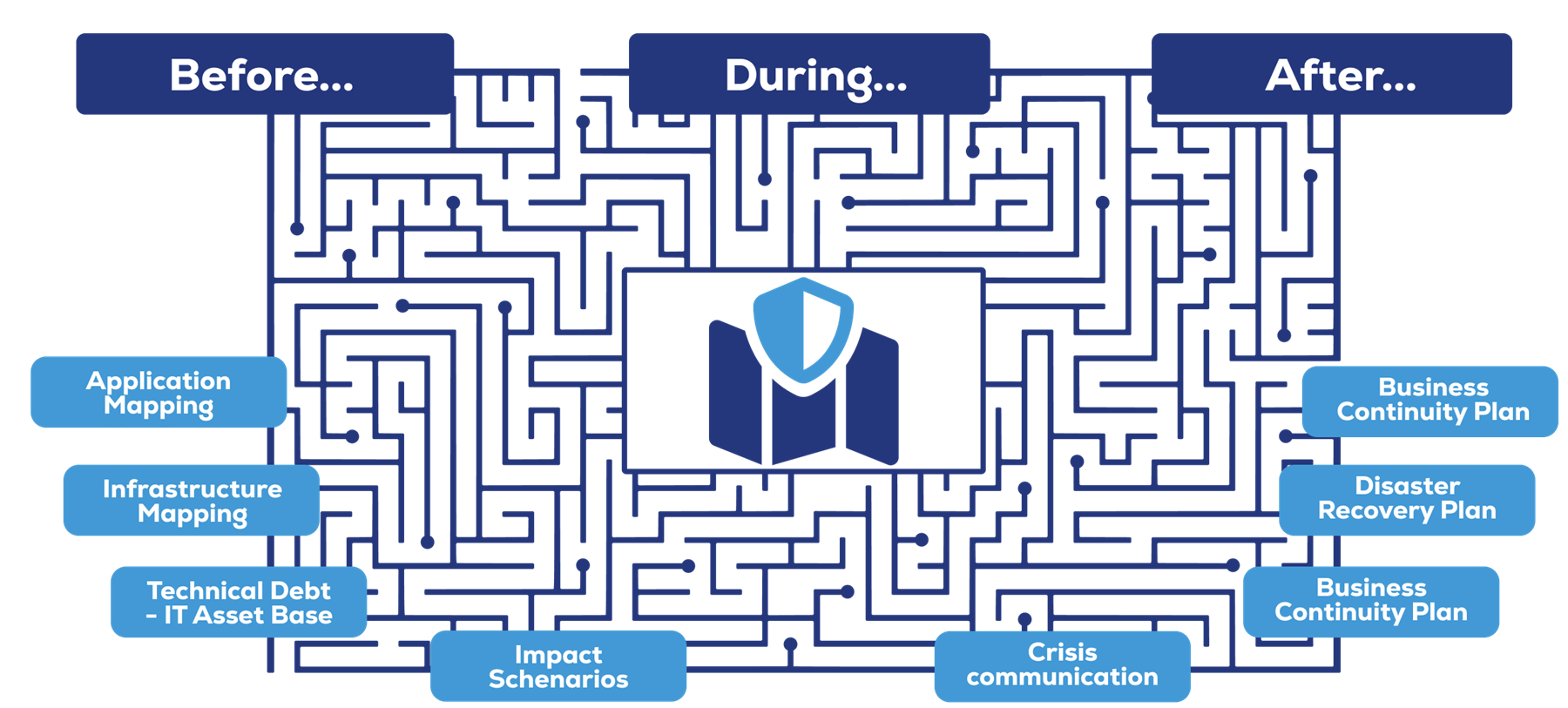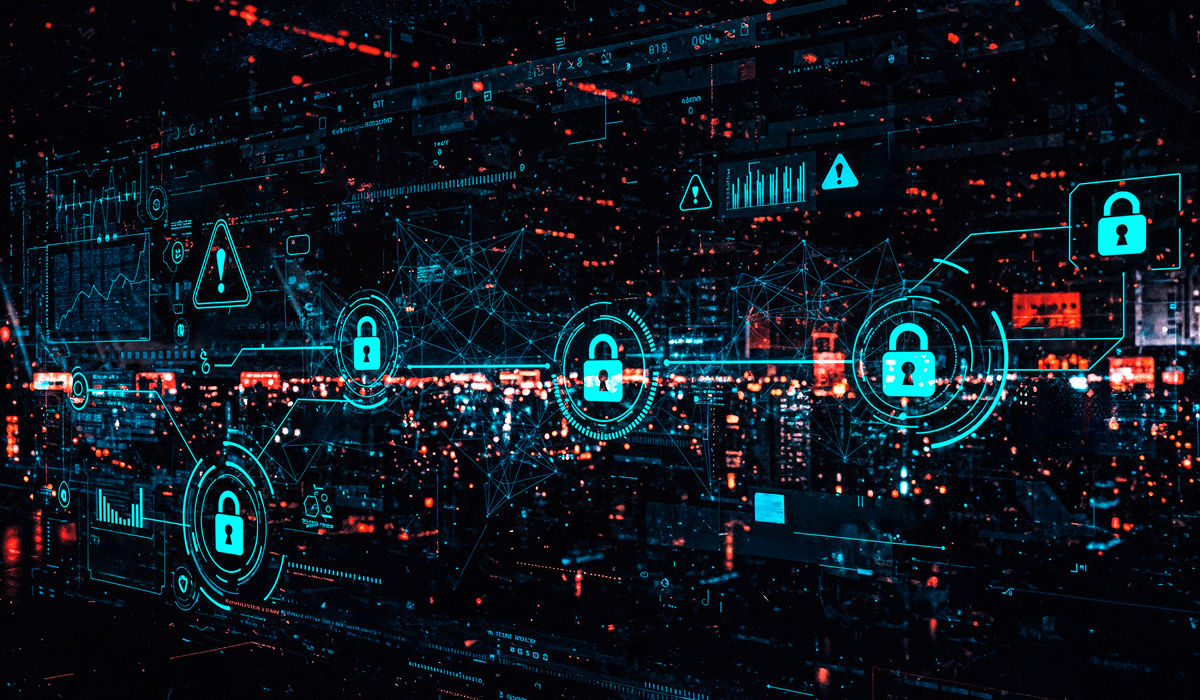IT mapping and cybersecurity are now inseparable. For CIOs, the question is no longer whether an information system will be attacked, but when.
One of the first questions ANSSI (the French National Cybersecurity Agency) asks when responding to a cyberattack is: Do you have a map of your information system?
Without IT mapping, it is extremely difficult to implement an effective action plan or cybersecurity strategy.
You need to know your digital territory in order to assess risks, build resilience, and comply with security standards and requirements.
IT mapping has become a must-have cybersecurity tool. Yet, it remains underutilized or limited to basic inventories. And if we accept that cyberattacks are inevitable, we must already prepare for crisis management and business recovery.
This article explores the concrete benefits of IT mapping at every critical stage: before, during, and after a cyberattack.
This article follows AB+ Software’s presentation at the Cybersecurity Day organized by SESAN.

Why IT Mapping Is Essential for Cybersecurity ?
When ANSSI makes mapping a prerequisite
IT mapping provides a visual, technical, and functional representation of your IT assets: applications, servers, networks, data flows, users. It is at the heart of ANSSI’s recommended best practices, due to its key contributions:
- Identification of critical or obsolete zones ;
- Analysis of interdependencies to prevent cascading failures ;
- Visibility of actual data flows, often different from theoretical ones ;
- Support for security documentation, governance, and audits.
IT Mapping Guide published by ANSSI
IT mapping also allows CISOs to go beyond a purely technical approach to cybersecurity. By linking business processes with related applications and data flows, it enhances visibility on business implications.
How well do you know your IT environment and business assets? First of the 13 recommendations in the ANSSI Cybersecurity Guide
ANSSI - National Cybersecurity Agency of France
Ensuring Compliance with Your Sector’s Security Standards
Depending on your industry or certification goals, mapping is crucial to achieving compliance, producing deliverables, and auditing your information system.
IT mapping plays a central role in compliance audits for regulations like ISO 27001, NIS2, or the GDPR. These require a detailed understanding of IT assets and data flows. Mapping centralizes this information, making it easier to document risks, personal data processing, and implemented security measures. It becomes a practical tool to demonstrate compliance, build your ISMS, and maintain your processing registry.
Mapping Before, During, and After a Cyberattack
Cybersecurity is a 24/7 concern. Whether you need to anticipate threats, respond to a crisis, or rebuild your system, mapping supports you at every stage. Because the real question is not if, but when you’ll be attacked.

Before the Attack: Anticipate Risks, Reduce Exposure, Ensure Compliance
Audit and Visualize Critical Assets
A dynamic, up-to-date IT map provides a comprehensive view of your IT landscape, or at least, that’s the objective. Achieving full coverage and maintaining high data quality are both significant challenges. Yet even a partial map of your information system reveals sensitive assets, end-of-life systems, risky interconnections, and blind spots.
A well-maintained map delivers vital insights to strengthen the resilience of your information system.
Real-world example: A financial services company discovered through its mapping process that several of its sensitive application flows were still exposed, unencrypted and running through undocumented channels. This revelation led to the closure of vulnerable entry points that could have been exploited by cybercriminals.
Reduce Technical Debt
By identifying obsolete components, unencrypted flows, and isolated applications, IT mapping helps prioritize remediation efforts. It brings to light technical debt, one of the most common attack vectors.
Mapping enables precise and dynamic tracking of software versions and end-of-life dates for foundational systems such as databases (DBMS) and operating systems. With a simple color-coded system, technical debt becomes immediately visible on your maps.
Note: Your IT mapping tool will gain even more value when integrated with IT encyclopedias to automatically track version histories of your components.
Real-life example: A cybersecurity risk review revealed critical vulnerabilities in components the teams believed had already been decommissioned.
Rationalize the Information System
An undeniable reality with real consequences: information systems constantly grow and become more complex. But that doesn’t make it inevitable.
IT mapping enables a precise inventory of your application landscape and helps identify and eliminate redundancies and overlaps.
The fewer the applications, the more resilient your information system becomes.
In this rationalization approach, mapping also allows you to align the criticality of your applications and infrastructure with business criticality. This not only strengthens resilience, it also leads to cost savings.
During the Attack: React Quickly and Effectively
Prepare with Impact Scenarios
Mapping allows simulation of crisis scenarios attacks on critical applications, infrastructure breaches, inter-application flow disruptions and supports the development of Business Continuity Plans (BCPs).
Some organizations integrate IT maps into cyber range exercises to train their teams in crisis response.
Isolate, Contain, Decide with Maps
During an attack, every minute counts. Mapping provides an operational view of interconnections and live data flows. It helps isolate compromised systems, contain spread, and guide critical decisions.
One of the first questions ANSSI teams ask during an incident is:
« Do you have an IT map of your system? »
Ensure Map Availability During an Incident
Your mapping tool itself must remain accessible during a crisis. This means choosing robust technical solutions:
- On-premises deployment on resilient infrastructure.
- Or SaaS solutions with guaranteed access, even in degraded mode
“Too many companies lose their key management tools at the moment they need them most.” – Digital Continuity Observatory
Improve Crisis Communication
Who is affected by an application failure? Which compromised data must be reported to the CNIL under GDPR? What departments are impacted? Who needs to be notified internally? Which clients are affected?
These are just some of the questions you’ll need to answer quickly to craft your internal and external communications. The good news? Your IT map can help you respond clearly and efficiently. By pinpointing the attack vectors, you can quickly trace back to affected business units, impacted data flows, and the responsible stakeholders.
IT mapping facilitates crisis communication between the CIO, CISO, executive management, business leaders, and your entire ecosystem. It provides communication tools and visuals that are understandable to all members of your crisis unit, even those unfamiliar with the technical details of your information system.
After the Attack: Rebuild and Strengthen
Drive Recovery with the Disaster Recovery Plan (DRP)
Mapping provides a roadmap for restoring services based on criticality and dependencies, supporting phased recovery efforts.
Strengthen Resilience Through Lessons Learned
Post-incident, mapping helps document root causes, adjust procedures, and improve governance. It supports incident feedback and audit processes.
“Less than 30% of companies that suffer an attack establish a formal improvement plan.” – PwC France
Preserve Organizational Knowledge
A well-maintained IT map builds organizational memory. It helps onboard new employees, ensures knowledge transfer, and supports continuity when experts leave.
How to Choose an IT Mapping Tool for Cybersecurity ?
Deploying IT mapping improves overall IT governance. It supports not just cybersecurity but also digital transformation, rationalization, IT governance, project management, and enterprise architecture.
The more integrated the tool is across departments, the better the data quality and completeness. Mapping is a collaborative process. Here are key features to look for :
- Flexibility: Your tool must evolve as your system evolves. myCarto’s meta-model is a major asset.
- Automation: Native connectors to IT tools (CMDBs, directories, monitoring).
- Business and technical views: Tailored visualizations for CISOs, architects, and business leads.
- Availability in crisis: Secure on-prem or resilient SaaS with uninterrupted access to key data.
- Ease of maintenance: Agile updating and operational readiness.
- User-friendliness: Intuitive, exportable, shareable interfaces.
myCarto is designed to meet all these requirements, offering a perfect balance of performance, accessibility, and resilience.
Discover the Full Potential of IT Mapping to Strengthen Your Cybersecurity
FAQ: IT Mapping & Cybersecurity
Can mapping prevent an attack?
No, but it helps limit vulnerabilities and reduces the impact by making response and recovery easier.
How often should the map be updated for optimal security?
At a minimum, after every major change to the IS. Ideally, continuously through automation.
Should the entire IS be mapped?
Ideally, the entire information system should be mapped. At the very least, it’s recommended to document the domains that are critical to business operations. The level of detail should then be adjusted based on the criticality of each area.
Does mapping replace a CMDB?
No, it complements it by providing a more visual, dynamic, and business-oriented view. It also enables visualization of interactions within the information system. It is recommended to interface your mapping tool with all resources that describe your IS.
Discover our integration approach
What ROI can be expected from mapping for cybersecurity?
Improved responsiveness, reduced downtime, and informed governance during critical situations.
Conclusion
IT mapping is no longer optional : it is a key operational tool for any cybersecurity strategy. Before an attack, it reveals weaknesses. During a crisis, it guides decisions. Afterward, it supports rebuilding efforts.
With myCarto, adopt an evolving, always-available mapping solution, designed to strengthen the resilience of your information system.
By offering a complete and dynamic view of your IT architecture, mapping helps identify redundancies, optimize resources, and better plan digital transformation. By following the practical steps outlined, from initial audit to continuous improvement, you reduce complexity, boost system performance, and lower operational costs.
Simplifying your IT infrastructure is not just a technical necessity, it’s a strategic lever for growth and competitiveness. With the right tools and a structured approach, infrastructure management becomes a major asset to your business success.


